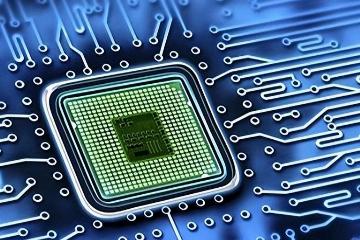In recent times, the chip industry has seen significant fluctuations that leave many pondering its futureThis isn't just an isolated event; it primarily revolves around the interactions between two key players in the global semiconductor landscape: China and the United StatesThe dynamics between these two nations have a profound impact on chip manufacturers, especially in how they navigate the intricate web of supply and demand amidst global economic pressures.
The epicenter of the current struggle can be traced back to the latest financial reports from major semiconductor companiesFor instance, Intel, once a titan of the industry, reported an alarming downturn in its third-quarter results for 2023. The company's revenue plummeted by 20% year-on-year, with net profits sinking by an astonishing 85%. Such drastic shifts raise questions about the sustainability of its operational model, especially when the company simultaneously explores aggressive layoffs amounting to approximately 20% of its global workforce of 121,000.
While Intel appears to be contracting, the landscape is equally complex across the board, with Advanced Micro Devices (AMD) reporting its struggles
Advertisements
AMD experienced a notable 40% decline in its PC processor segment, which subsequently dragged down its overall net profit by 93%. This stark contrast in fortunes between companies in the semiconductor industry illustrates the delicate balance at play and calls into question their future production capabilities.
A striking observation in recent reports is the trend emerging from TSMC, the leader in the semiconductor foundry spaceTSMC announced a drastic revision of its capital expenditure plans amidst a weakening semiconductor marketThe revelation that a major client cancelled a significant order underscores growing uncertaintiesMany speculate that Apple, a cornerstone client, is anticipating a considerable dip in demand for its products, leading to decreased chip ordersThis cancellation sends ripples throughout the supply chain, demonstrating that even the largest players cannot escape the cascading effects of market demand fluctuations.
As we shift our focus to the Chinese semiconductor landscape, the revelations are equally compelling
Advertisements
SMIC's ambitious plan to invest 170 billion yuan in constructing four new 12-inch wafer fabrication facilities in Beijing, Tianjin, Shenzhen, and Shanghai sends a bold messageThis investment equates to the entirety of the company’s revenue for the past three and a half years, suggesting a strong confidence in local demand and the future of chip manufacturing in China.
One might wonder how SMIC can boldly expand its capacity when others are contractingThe answer lies in the divergent trajectories of the U.Sand Chinese marketsThe U.Ssemiconductor industry faces a profound contraction, largely driven by reduced consumer demand for electronicsThis decline is exacerbated by rising interest rates, which dampen both investment and consumer spendingAs companies retract and consumers tighten their belts—in large part due to high expenses stemming from heightened mortgage rates—the demand for semiconductors continues to dwindle.
In essence, rising interest rates have a dual impact on the semiconductor market
Advertisements
Not only do they deter new investments in technology and innovation, but they also shift consumer behavior—especially in a culture where many Americans previously favored a "spend now, save later" mindsetWith inflation pressures adding to financial strains, consumers are increasingly reluctant to purchase new electronics, creating a vicious cycle of falling sales and slumping revenues for chip manufacturers.
The contrasting strategies between the U.Sand China display a shift from a seller's market to a buyer's market, where market dynamics dictate supplier behaviorFurthermore, the U.S.'s ongoing efforts to maintain its competitive edge in semiconductors—coupled with its desire to minimize dependence on foreign suppliers—has arguably led to an unintended consequence: Alienating customers and driving them toward self-sufficiency in chip production
- Han's M&A Faces Hurdles in Hong Kong
- 2024: A Milestone Year for AI
- Polysilicon Production Cuts to Impact PV Market
- Western Chip Firms Double Down on China
- Hong Kong Dividend Plays Offer Value
The rise of companies like Oppo and Xiaomi highlights this trend; once reliant on American chip suppliers, they've begun investing heavily in their own chip development capabilities.
While China expands its footprint in chip manufacturing, it’s crucial to recognize the structural challenges it facesDespite the progress, domestic funding sources are tightening as American investment channels shrink, predominantly due to geopolitical tensionsWith venture capital traditionally coming from both nations, the blockage of U.Sfunds poses new risks for many startups within China's semiconductor ecosystemIf these funds dry up, it could stall the momentum they're currently experiencing.
Moreover, the heightened scrutiny of investment channels has led many Chinese companies to consider strategizing their financial foundations, separating themselves from U.S

capital in preparation for potential legal complicationsThis shift, however, raises concerns about long-term growth and the sustainability of innovative breakthroughs in the sector.
The semiconductor industry, by nature, demands hefty investments with extended ROI cycles, which poses significant risks amidst economic uncertaintyWith the influx of homegrown designs and technologies, however, there is a glimmer of hope—much of these advancements are driven by a wave of new designers seeking to localize chip design, paving the way for potential partnerships within domestic manufacturing ecosystems.
In conclusion, the ongoing semiconductor saga underscores the juxtaposition of contraction in the U.Smarket against China’s ambitious drive toward self-sufficiencyThe developments at SMIC serve as a testament to China's commitment to bold aspirations—even amid market pressures